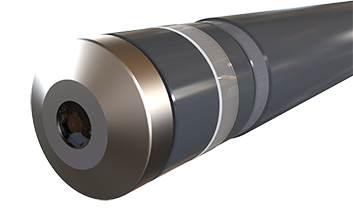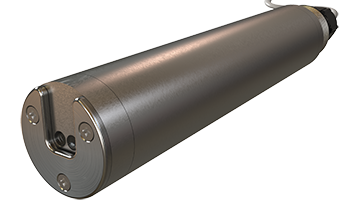You probably know that the UV254 water quality parameter is a measurement of the absorbance of light by a water sample at 254nm wavelength and often can be used to correlate with the other water quality parameters but did you know that……..
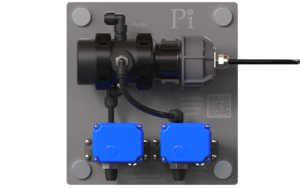
…….The absorbance can be used as a cheaper, easier and more reliable surrogate than online TOC or COD?
…….the total cost of ownership of a UV254 instrument is a very small fraction of the cost of, for example, a TOC instrument?
……Although it is possible for there to be no correlation between UV254 absorbance and other water quality parameters in natural water, there is usually a simple linear relationship between UV254 and TOC?
UV254 Absorbance
UV254 is an optical technology which utilises light in the UV at a wavelength of 254nm and is able to detect organic matter in the water. Typically, its measurement is presented as a calculation of UV absorbance (UVA) or UV transmittance (UVT). Absorbance measurements are very common in the laboratory and in the field since absorbance at a given wavelength is linearly proportional to the concentration of any substances in the water that are known to absorb light at the given wavelength.
Correlating UV254 to other Organics
Light at 254nm wavelength is of particular interest since it is a wavelength that is very readily absorbed by organic matter in the water.
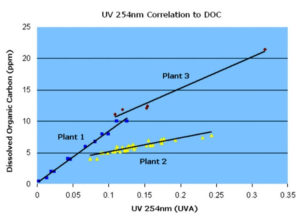
Because the UV254 absorbance parameter is proportional to the concentration of organics in the water, it is a simple process to determine a linear correlation factor that relates the UV254 parameter to other water quality parameters that provide a measure of organic matter in the water. There are several such water quality parameters including total organic carbon (TOC), chemical oxygen demand (COD), biological oxygen demand (BOD), and colour (Hazen). All these parameters have slightly different biases to different types of organic matter. UV254 can often be linearly correlated to all of these parameters.*
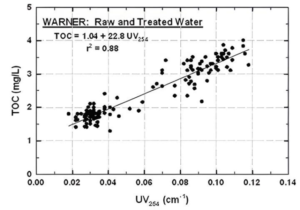
The correlation factor will depend on the particular organic water quality parameter being correlated to and will also depend on the matrix of organics being measured. This means that the correlations are site and application specific and so the correlation factor must be determined at the measurement site.
Most natural water sources such as raw water for drinking water and municipal wastewater have a good correlation between, for example TOC and UV254 absorption, and COD and UV254 absorption.
The solution from Pi
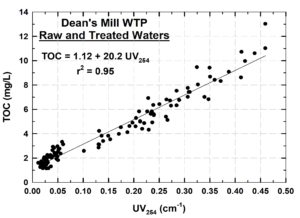
The UV254Sense Probe is a practical solution to a correlated UV254 absorbance signal to, for example TOC. The way Pi’s UV254Sense Probe provides an output for a correlated parameter is by applying an offset and calibration to the UV254 measurement. This is calculated by setting up a ‘virtual channel’ in the instrument. This channel is then related to the original UV254 measurement by way of a formula in the form of y = ax + b where
Y is the correlated water parameter (eg. TOC, COD)
X is the UV254 absorption
A is a factor to be applied to x (changing the slope)
B is an offset (changing the zero)
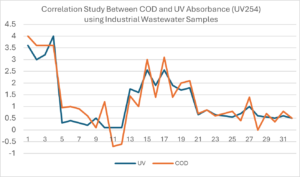
In order to calculate a and b, sufficient data must be collected over time to generate a graph similar to the graph on the right. A spreadsheet program can then fit a straight line to the data and provide a formula in the form y = ax + b in order for it to be entered into the Pi UV254Sense.
The virtual correlated channel can then be used as a measurement parameter to generate alarms, control a PID loop, display on the instrument etc.
In order to derive a correlation between TOC, DOC, BOD or COD and UVA, data will need to be gathered using both parameters over a period of time.
*Please note that it is possible for there to be no correlation between UV254 absorbance and other quality parameters if that parameter on particular water source does not contain UV254 absorbing substances. An example of this would be a water supply containing a lot of dissolved sugar, as sugar won’t absorb UV254 but will have a high Chemical Oxygen Demand (COD).
Previous Post
UV254 Portable


